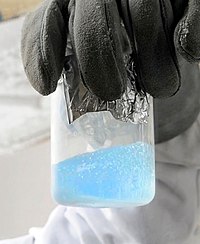
Photo from wikipedia
Energy storage systems (ESS) that are cost-effective and capable of running stably for years or decades are key to the large-scale application of the intermittent renewable energy resources. For most… Click to show full abstract
Energy storage systems (ESS) that are cost-effective and capable of running stably for years or decades are key to the large-scale application of the intermittent renewable energy resources. For most of the transition metal (TM) oxide cathode materials, charge compensation is realized by the reduction and oxidation of the TM ions during the electrochemical cycling. However, oxygen evolution prior to the full oxidation of the TM ions is often unavoidable due to the strong O-p/TM-d covalent hybridization.[1] Recent studies show that enhancing the strength of the TMO bonds can stabilize the oxygen, which in turn helps to break through the bottleneck and achieve a higher capacity, as is expected for the Li-rich layered oxides.[2] However, the long-term reversibility of the oxygen redox reactions remains challenging though such reactions are really attractive. Oxygen oxidation was reported Cathode materials with high energy density, long cycle life, and low cost are of top priority for energy storage systems. The Li-rich transition metal (TM) oxides achieve high specific capacities by redox reactions of both the TM and oxygen ions. However, the poor reversible redox reaction of the anions results in severe fading of the cycling performance. Herein, the vacancy-containing Na4/7[Mn6/7(◻Mn)1/7]O2 (◻Mn for vacancies in the MnO slab) is presented as a novel cathode material for Na-ion batteries. The presence of native vacancies endows this material with attractive properties including high structural flexibility and stability upon Na-ion extraction and insertion and high reversibility of oxygen redox reaction. Synchrotron X-ray absorption near edge structure and X-ray photoelectron spectroscopy studies demonstrate that the charge compensation is dominated by the oxygen redox reaction and Mn3+/Mn4+ redox reaction separately. In situ synchrotron X-ray diffraction exhibits its zero-strain feature during the cycling. Density functional theory calculations further deepen the understanding of the charge compensation by oxygen and manganese redox reactions and the immobility of the Mn ions in the material. These findings provide new ideas on searching for and designing materials with high capacity and high structural stability for novel energy storage systems.
Journal Title: Advanced Energy Materials
Year Published: 2018
Link to full text (if available)
Share on Social Media: Sign Up to like & get
recommendations!